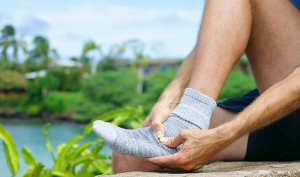 Cuboid
syndrome describes the dislocation or subluxation of the cuboid bone, meaning it has moved out of place and alignment relative to the rest
of the bones of the foot. The cuboid bone is located on the outside of your foot, connecting at its front side with the fourth and
fifth metatarsals (long bones of the foot) and at its back end, with the heel bone (calcaneus). It is held in place by ligaments and a
joint capsule. Damage to these tissues can cause the cuboid to move out of place, resulting in painful symptoms on the outside of the
ankle.
Cuboid
syndrome describes the dislocation or subluxation of the cuboid bone, meaning it has moved out of place and alignment relative to the rest
of the bones of the foot. The cuboid bone is located on the outside of your foot, connecting at its front side with the fourth and
fifth metatarsals (long bones of the foot) and at its back end, with the heel bone (calcaneus). It is held in place by ligaments and a
joint capsule. Damage to these tissues can cause the cuboid to move out of place, resulting in painful symptoms on the outside of the
ankle.
The two primary causes of cuboid syndrome include injury and overuse. Pronation, or flat feet, has shown to be present in a majority of people that are affected by cuboid syndrome, with other risk factors including poor footwear, a history of previous injury, running on uneven surfaces and obesity.
Injuries that cause the foot to twist inwards while pushing the cuboid out can dislocate the cuboid bone and cause cuboid syndrome. This often occurs in an inversion ankle sprain where the outside (lateral) ligaments can be overstretched and no longer hold the cuboid effectively in place. Other injuries can include falls and misstepping.
Overuse injury to the cuboid typically occurs through the abnormal strain of the peroneus longus muscle, which runs down the outside of the leg and down around the outside of the ankle. Repetitive strain on the peroneus longus through activities such as running and ballet can pull on the cuboid and cause it to dislocate over time.
The main symptom of cuboid syndrome is pain on the outside of the foot, which may be exacerbated by weight-bearing. Other symptoms may include:
Initially, the PRICE principles (protection, rest, ice, compression and elevation) can help to reduce swelling and painful symptoms. The cuboid will then need to be manipulated back into place. Following this, treatment focuses on facilitating the healing and repair of the tissues around the cuboid, as well as reducing the risk of future re-injury. This may include:
.png)
Since introducing shockwave therapy, we’ve helped many of our patients avoid surgery for certain conditions. Here's what you
need to know about shockwave treatment and how it works.
.png)
This Mother’s Day, consider a practical, medically safe, and confidence-boosting gift: a professional KeryFlex nail restoration treatment. It’s a simple, effective, and medically safe way to instantly transform the appearance of toenails.
Keeping your family on their feet and helping them to walk, run, play and exceed their goals is why we love getting up in the morning.
Ground Floor, One Health Building
122 Remuera Rd, Remuera
Auckland 1050, New Zealand
| MON - FRI | 7:30am – 6:30pm |
| SAT | 8:30am – 4:30pm |
| SUN | Some availability |
Make an Appointment
Online Schedule